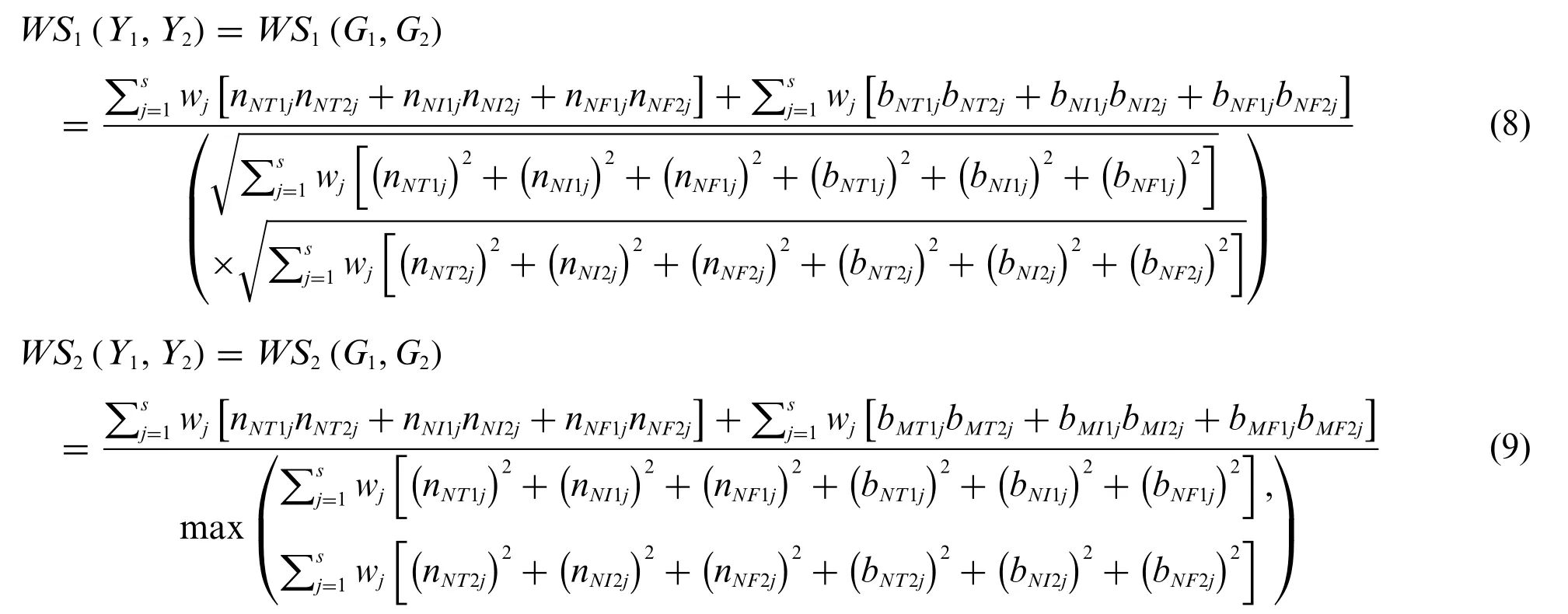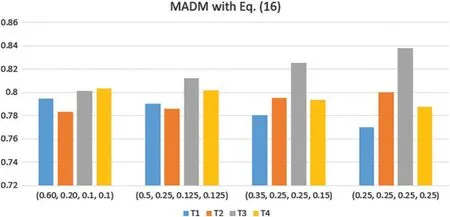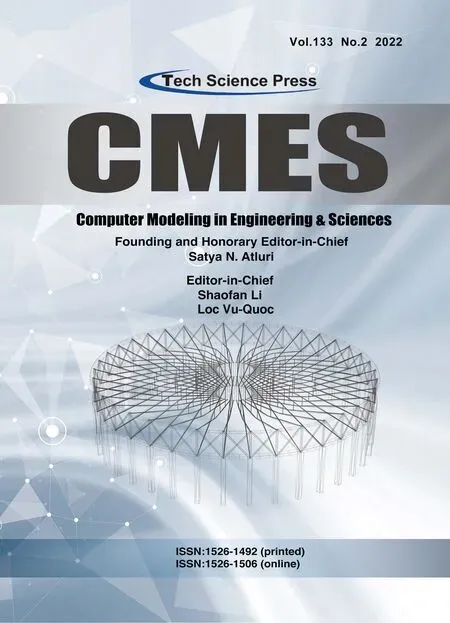Cotangent Similarity Measure of Consistent Neutrosophic Sets and Application to Multiple Attribute Decision-Making Problems in Neutrosophic Multi-Valued Setting
Angyan Tu,Jiancheng Chen and Bing Wang
1School of Mechatronic Engineering and Automation,Shanghai University,Shanghai,200444,China
2Department of Computer Science and Engineering,Shaoxing University,Shaoxing,312000,China
3Zhejiang Industry Polytechnic College,Shaoxing,312000,China
ABSTRACT A neutrosophic multi-valued set (NMVS) is a crucial representation for true,false,and indeterminate multivalued information.Then,a consistent single-valued neutrosophic set (CSVNS) can effectively reflect the mean and consistency degree of true,false,and indeterminate multi-valued sequences and solve the operational issues between different multi-valued sequence lengths in NMVS.However,there has been no research on consistent single-valued neutrosophic similarity measures in the existing literature.This paper proposes cotangent similarity measures and weighted cotangent similarity measures between CSVNSs based on cotangent function in the neutrosophic multi-valued setting.The cosine similarity measures show the cosine of the angle between two vectors projected into a multidimensional space,rather than their distance.The cotangent similarity measures in this study can alleviate several shortcomings of cosine similarity measures in vector space to a certain extent.Then,a decisionmaking approach is presented in view of the established cotangent similarity measures in the case of NMVSs.Finally,the developed decision-making approach is applied to selection problems of potential cars.The proposed approach has obtained two different results,which have the same sort sequence as the compared literature.The decision results prove its validity and effectiveness.Meantime,it also provides a new manner for neutrosophic multi-valued decision-making issues.
KEYWORDS Neutrosophic multi-valued set;consistency single-valued neutrosophic sets;cotangent similarity measure;multiple attribute decision-making
1 Introduction
Zadeh [1] proposed fuzzy sets for the first time to deal with fuzzy information in uncertain problems.Atanassow[2]further extended the fuzzy set and proposed the intuitionistic fuzzy set,which is described by a membership degree and a nonmembership degree.Smarandache [3] proposed the concept of a neutrosophic set(NS)considering the truth,falsity,and determinacy membership degrees.NS shows its main merit in dealing with indeterminate and inconsistent information.Hence,NSs have been widely used in image segmentation[4,5],decision making[6],clustering analysis[7],and so on.Wang et al.[8] introduced the concept of a single-valued neutrosophic set (SVNS) within the real interval [0,1] to more effectively solve practical problems.For example,some similarity measures of SVNSs were applied in multiple attribute decision-making (MADM) [9,10] and clustering analysis[11].Then,the cross entropy of SVNSs was utilized for MADM[12]and object tracking[13].Some aggregation operators of SVNSs and correlation coefficients of SVNSs were used for MADM[14,15].As the subclass of NS,some aggregation operators of simplified NSs(containing SVNSs and interval NSs)[16–18]and similarity measures of simplified NSs[19]were presented and used for MADM.
When considering neutrosophic multi-valued/hesitant information,some similarity measures of single-valued neutrosophic multisets (SVNMs) were proposed and used for medical diagnosis[20] and MADM [21].Multi-valued/hesitant NSs were introduced and applied in decision-making[22–29].However,MVNS loses some identical neutrosophic values due to hesitant characteristics,thus the information aggregation of MVNSs may produce the union of multiple aggregated values in MADM problems,which may lead to computational complexity [24].Furthermore,converting single-valued neutrosophic sequences in SVNM into SVNS[21]only contains the average value in the transformation process,which may lead to the loss of useful information (e.g.,standard deviation).To solve these issues,Ye et al.[30]proposed a neutrosophic multi-valued set(NMVS),which contains identical and/or different true,false and indeterminate values,and defined a new method that converts NMVS into consistent single-valued neutrosophic sets(CSVNSs)in view of the mean and consistent degree of the true,false and indeterminate sequences.They also introduced the correlation coefficients of CSVNSs and applied them to MADM.
However,a similarity measure for CSVNSs was studied in the literature [30] as it is a key mathematical tool for MADM problems in the setting of NMVSs.Therefore,we should propose new similarity measures of CSVNSs to perform MADM in the case of NMVSs.In this paper,two cotangent similarity measures of NMVSs are proposed and applied to the purchase decision issue of potential cars.The rest of the paper consists of the following sections.Section 2 introduces some concepts of NMVSs and CSVNSs.The cotangent similarity measures of the CSVNSs are established from the cotangent function,and the properties of the cotangent similarity measures are demonstrated in Section 3.Section 4 introduces the MADM algorithm with respect to the established cotangent similarity measures of CSVNSs.Section 5 presents an example of purchase decision issues of potential cars and the comparative results of the related approach to prove the effectiveness and rationality of the new approach.Finally,conclusions and further works are put forward in Section 6.
2 Some Concepts of NMVSs and CSVNSs
This section introduces some concepts of NMVSs and CSVNSs presented by Ye et al.[30].
Definition 2.1[30].LetD={d1,d2,...,ds}be a finite set.A NMVSYdefined onDis given by

whereNFY(dj),NIY(dj) andNTY(dj) are the falsity-membership function,the indeterminacy membership function,and the truth membership function,respectively,which are described by three multi-valued sequenceswith different and/or identical fuzzy values,and 0 ≤supNTY(dj)+supNIY(dj)+supNFY(dj)≤3 fordj∈D(j=1,2,...,s).
The basic element
Definition 2.2 [30].Setis thejth NMVE.By means of the average values ofNTj,NIj,andNFjand the consistent degrees ofNTj,NIj,andNFj(j=1,2,...,s),the CSVNSG={g1,g2,...,gs}is transformed from NMVS.The consistent single-valued neutrosophic element(CSVNE)of CSVNS is represented bygj=<(nNTj,bNTj),(nNIj,bNIj),(nNFj,bNFj)>(j=1,2,...,s),wherenNTj,nNIj,nNFj∈[0,1]are the average values ofNTj,NIj,andNFjandbNTj,bNIj,bNFj∈[0,1]are the consistent degrees ofNTj,NIj,andNFj.Then,the average values ofNTj,NIj,andNFjand the consistent degrees ofNTj,NIj,andNFjare obtained by the following formulae.

whereδNTj,δNIj,δNFj∈[0,1]are the standard deviations corresponding toNTj,NIj,andNFj(j=1,2,...,s),respectively,andqjis the number of fuzzy values inNTj,NIj,andNFj.
For two CSVNEsgj=<(nNTj,bNTj),(nNIj,bNIj),(nNFj,bNFj)>(j=1,2),both contain the following relationships:
(1)Ifg1⊆g2,there arenNT1≤nNT2,nNI1≥nNI2,nNF1≥nNF2,bNT1≤bNT2,bNI1≥bNI2,andbNF1≥bNF2;
(2)Ifg1⊆g2andg2⊆g1,there arenNT1=nNT2,nNI1=nNI2,nNF1=nNF2,bNT1=bNT2,bNI1=bNI2,andbNF1=bNF2.
By means of the average values ofNTj,NIjandNFjand the consistent degrees ofNTj,NIj,andNFj,weighted correlation coefficients between CSVNSs are introduced below[30].
Definition 2.3[30].SetY1={y11,y12,...,y1s}andY2={y21,y22,...,y2s}as two NMVSs,whereyij= wherebNTij,bNIij,bNFij,nNTij,nNIij,andnNFijare the consistent degrees and average values ofNTij,NIij,andNFij(i=1,2;j=1,2,...,s),which are produced by Eqs.(2)–(7). This section introduces cotangent similarity measures and weighted cotangent similarity measures between CSVNSs and their properties. Definition 3.1.LetY1={y11,y12,...,y1s} andY2={y21,y22,...,y2s} be two NMVSs,whereyij= wherebNTj,bNIj,bNFj,nNTj,nNIj,andnNFjare the consistent degrees and average values ofNTij,NIij,andNFij,which are produced by Eqs.(2)–(7). Proposition 3.1.The cotangent similarity measuresCot1(G1,G2)andCot2(G1,G2)in CSVNSs have the following properties: (Z1)Cot1(G1,G2)=Cot1(G2,G1)andCot2(G1,G2)=Cot2(G2,G1); (Z2)0 ≤Cot1(G1,G2),Cot2(G1,G2)≤1; (Z3)Cot1(G1,G2)=1 if only ifG1=G2; (Z4) For any CSVNS G3andG1⊆G2⊆G3,Cot1(G1,G2) ≥Cot1(G1,G3) andCot2(G2,G3) ≥Cot2(G1,G3). Proof:(Z1)It is obvious that the proof of the property(Z1)is straightforward. (Z2)Since the values of|nNT1j−nNT2j|,|nNI1j−nNI2j|,|nNF1j−nNF2j|,|bNT1j−bNT2j|,|bNI1j−bNI2j|and|bNF1j−bNF2j|forj=1,2,...,sare between 0 and 1 and the value of cotangent function falls in the interval[π/4,π/2],the cotangent values in Eqs.(10)and(11)are also located between 0 and 1.Hence,there is 0 ≤Coti(G1,G2)≤1 fori=1,2. (Z3)For the two CSVNSsG1andG2,ifG1=G2,this impliesnNT1j=nNT2j,nNI1j=nNI2j,nNF1j=nNF2j,bNT1j=bNT2j,bNI1j=bNI2jandbNF1j=bNF2jforj=1,2,...,s.Hence|nNT1j−nNT2j|=0,|nNI1j−nNI2j|=0,|nNF1j−nNF2j|=0,|bNT1j−bNT2j|=0,|bNI1j−bNI2j|=0,and|bNF1j−bNF2j|=0.ThusCoti(G1,G2)=1 fori=1,2. IfCoti(G1,G2)=1 fori=1,2,this implies cot(π/4)=1 and|nNT1j-nNT2j|=0,|nNI1j-nNI2j|=0,|nNF1j−nNF2j|=0,|bNT1j−bNT2j|=0,|bNI1j−bNI2j|=0,and|bNF1j−bNF2j|=0 forj=1,2,...,s.Then,there arenNT1j=nNT2j,nNI1j=nNI2j,nNF1j=nNF2j,bNT1j=bNT2j,bNI1j=bNI2jandbNF1j=bNF2jforj=1,2,...,s.Therefore,there isG1=G2. (Z4)Since there existsG1⊆G2⊆G3,there are|nNT1j−nNT3j|≥|nNT1j−nNT2j|,|nNT1j−nNT3j|≥|nNT2j−nNT3j|,|nNI1j−nNI3j|≥|nNI1j−nNI2j|,|nNI1j−nNI3j|≥|nNI2j−nNI3j|,|nNF1j−nNF3j|≥|nNF1j−nNF2j|,|nNF1j−nNF3j|≥|nNF2j−nNF3j|,|bNT1j−bNT3j|≥|bNT1j−bNT2j|,|bNT1j−bNT3j|≥|bNT2j−bNT3j|,|bNI1j−bNI3j|≥|bNI1j−bNI2j|,|bNI1j−bNI3j| ≥|bNI2j−bNI3j|,|bNF1j−bNF3j| ≥|bNF1j−bNF2j|,and |bNF1j−bNF3j| ≥|bNF2j−bNF3j|.Since the cotangent function is a decreasing function within the interval[π/4,π/2],there areCot1(G1,G2)≥Cot1(G1,G3)andCot2(G2,G3)≥Cot2(G1,G3).When the importance of eachyijis different,the weight ofyij(i=1,2;j=1,2,...,s)is specified aswjwithwj∈[0,1]and Σs j=1wj=1.Thus,we present the weighted cotangent similarity measures of CSVNSs. Whenwj=1/s(j=1,2,...,s),Eqs.(12) and (13) are reduced to Eqs.(10) and (11),which are special cases of Eqs.(12)and(13). This part introduces a MADM approach corresponding to the proposed cotangent similarity measures in the setting of NMVSs.When dealing with a MADM problem,there is often a set of multiple alternativesT={T1,T2,...,Tq},evaluated by a group of multiple attributesE={e1,e2,...,es}.The weight vector ofEis specified asw=(w1,w2,...,ws).Each alternativeTi(i=1,2,...,q)is evaluated over the attributesejby a NMVEyij= Step 1:Using Eqs.(2)–(7),the NMVSYi={yi1,yi2,...,yis}and the decision matrixY=(yij)q.sare transformed into the CSVNSGi={gi1,gi2,...,gis}and the decision matrix of CSVNSsG=(gij)q.s,respectively. Step 2:The ideal solutionG∗=(g1∗,g2∗,...,gs∗)is determined by the ideal CSVNE: Step 3:The weighted cotangent similarity measures of the CSVNSsGiandG∗forTiare obtained by the following equations: or Step 4:According to the values of the weighted cotangent similarity measure,the alternatives are arranged in descending order,and the best one is selected. Step 5:End. To easily compare the proposed MADM approach with existing relevant MADM methods,this section presents an illustrative example on the selection purchase of potential cars in[21]to illustrate the effectiveness and rationality of the proposed MADM approach. Customers want to choose a suitable car according to their own living needs and driving habits.There are four types of potential cars,represented by the set of alternativesT={T1,T2,T3,T4}.They must satisfy the requirements of four indexes/attributes:(1)e1is the fuel economy;(2)e2is the price;(3)e3is the amenity;(4)e4is the safety.The weight vector ofE={e1,e2,...,es}is expressed asw=(0.5,0.25,0.125,0.125).The evaluation values of the four attributes for each alternative are expressed by the NMVEyij= Table 1:The decision matrix of NMVEs In the environment of NMVSs,we apply the proposed MADM approach to the MADM problem of the illustrative example and present the following algorithmic steps. Step 1:Using Eqs.(2)–(7),all NMVSs in Table 1 are transformed into the decision matrix of CSVNSs: For example,using Eq.(2),calculating equation (0.5 + 0.7)/2,we get 0.6,which is the value of the variable.Also,using Eq.(5),calculating equationwe get 0.8586,which is the value of the variable.With the same way,we obtain the other data. Step 2:By Eq.(14),the ideal solutionG∗=(g1∗,g2∗,...,gs∗)is yielded from the decision matrix CSVNSs as follows: Step 3:Using Eqs.(15)or(16),the values ofWCot1(Gi,G∗)orWCot2(Gi,G∗)(i=1,2,3,4)are obtained below: WCot1(G1,G∗)=0.6157,WCot1(G2,G∗)=0.4909,WCot1(G3,G∗)=0.5363,andWCot1(G4,G∗)=0.5205. Or WCot2(G1,G∗)=0.6171,WCot2(G2,G∗)=0.6086,WCot2(G3,G∗)=0.6552,andWCot2(G4,G∗)=0.6359. Step 4:The ranking of all alternatives isT1>T3>T4>T2orT3>T4>T1>T2,then the best one isT1orT3. To investigate sensitivity to the weights of the four attributes,we select four weight vectors and give the decision results of the potential cars,as shown in Table 2.It is obvious that different weight vectors can affect the ranking of the four alternatives,and shows some sensitivity to the weights of the four attributes in the example,as shown in Figs.1 and 2. Table 2:Decision results corresponding to four weight vectors Table 2 (continued)MADM method Weight vector Similarity measure value Ranking order The best one MADM with Eq.(16)(0.60,0.20,0.1,0.1) 0.7947,0.7831,0.8010,0.8035 T4>T3>T1>T2 T4(0.5,0.25,0.125,0.125) 0.7905,0.7857,0.8122,0.8017 T3>T4>T1>T2 T3(0.35,0.25,0.25,0.15) 0.7804,0.7950,0.8254,0.7938 T3>T2>T4>T1 T3(0.25,0.25,0.25,0.25) 0.7699,0.8000,0.8379,0.7873 T3>T2>T4>T1 T3 Figure 1:MADM with Eq.(15) Figure 2:MADM with Eq.(16) In this section,the proposed MADM approach based on the cotangent similarity measures is compared with the MADM method in[21,30]to prove the feasibility and effectiveness of the proposed MADM method. To enhance the comparability,we use the same weight vectorw=(0.5,0.25,0.125,0.125) for various MADM methods and present their decision results in Table 3.In Table 3,the ranking order of the proposed MADM approach using Eq.(15) is mostly consistent with the MADM method using Eq.(9) [30].Two Eqs.(15) and (9) [30] using the parameter ‘max’,which has the same result.It shows that the results are reasonable.Then,the ranking order of the MADM method proposed by Eq.(16)is calculated with the average,which is the same as the MADM method using the cosine measure[21].The comparison results show the efficiency of the proposed MADM approach.However,the MADM method using the cosine measure [21] does not consider the consistent degree in the MADM process,which may lead to the loss of some useful information and the difference in sorting results.Furthermore,the consistent degree of multi-valued sequences can affect the sorting results of alternatives,revealing the importance of the consistent information in MADM problems,and making the decision results more credible and reasonable. Table 3:Ranking orders of various MADM methods The advantages of the cotangent similarity measure in this study can make up for some deficiencies of the cosine similarity measure in the vector space to a certain extent.Using two different methods of cotangent similarity measures,different ranking results can be obtained.It shows that the results have excellent plasticity and rationality.At the same time,the method also provides a new way of thinking about the multi-valued decision-making problem. Based on the concepts of NMVS and CSVNSs,the cotangent similarity measures of CSVNSs are proposed by the cotangent function.The proposed MADM method using the cotangent similarity measures of CSVNSs is applied to perform the MADM problem with NMVSs.Then,the proposed MADM method is applied to the selection problem of potential cars to verify the effectiveness of the proposed MADM method.Compared with other MADM methods,the proposed MADM method shows its high efficiency and rationality.In future research,we will further develop other new similarity measures of CSVNSs and apply them in the fields of medical diagnosis/ assessment and image processing in the setting of NMVSs. Funding Statement:The authors received no specific funding for this study. Conflicts of Interest:The authors declare that they have no conflicts of interest to report on the present study.
3 Cotangent Similarity Measures of CSVNSs


4 MADM Approach Regarding the Proposed Cotangent Similarity Measures of CSVNSs



5 Illustrative Example

5.1 The Proposed MADM Approach for the Illustrative Example






6 Comparative Analysis

7 Conclusion
 Computer Modeling In Engineering&Sciences2022年11期
Computer Modeling In Engineering&Sciences2022年11期
